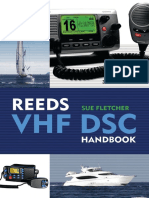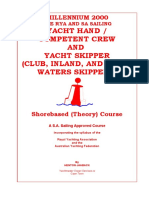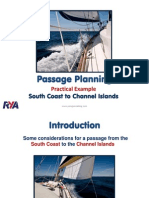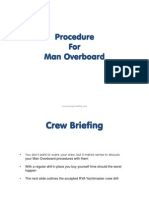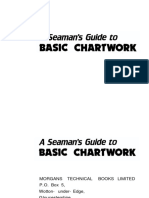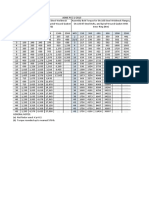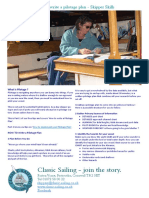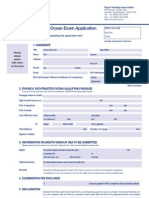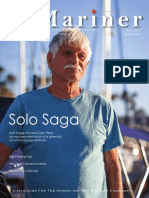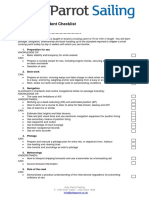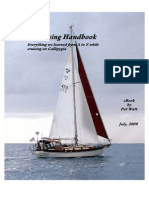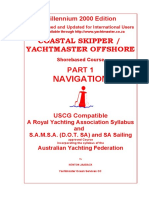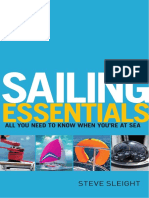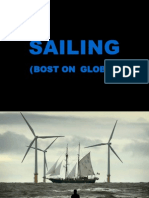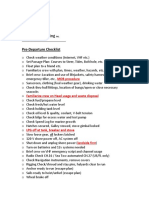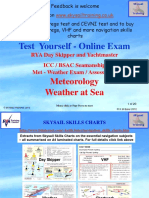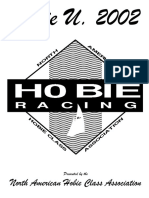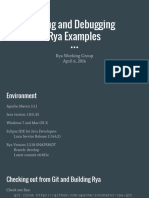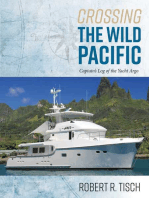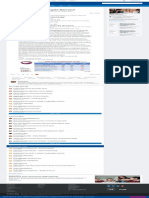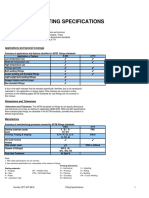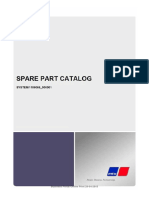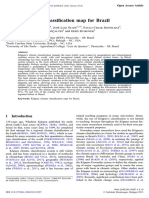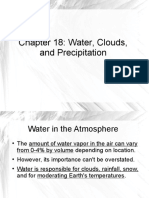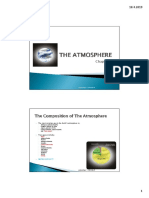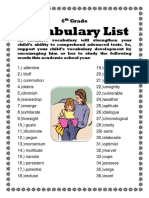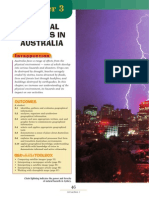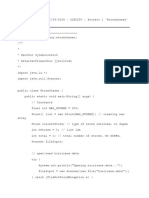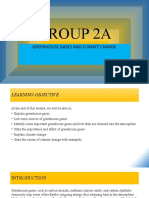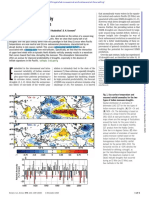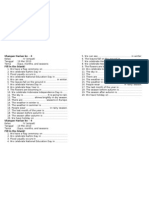Glenans Logbook
Glenans Logbook
Uploaded by
khaireddinCopyright:
Available Formats
Glenans Logbook
Glenans Logbook
Uploaded by
khaireddinOriginal Description:
Copyright
Available Formats
Share this document
Did you find this document useful?
Is this content inappropriate?
Copyright:
Available Formats
Glenans Logbook
Glenans Logbook
Uploaded by
khaireddinCopyright:
Available Formats
Glenans Irish Sailing Club
CRUISING LOGBOOK
Inside front cover
The Glenans Irish Sailing Club Cruising Logbook
GLENANS Irish Sailing Club
5 Lower Mount Street
Dublin 2
tel 01-661 1481
fax 01-676 4249
info@glenans-ireland.com
www.glenans-ireland.com
The Station House
Baltimore, Co. Cork
tel 028-20154
Boat Name
Home Port
Design Type
Call Sign
Owners Name
Registration Number
Address
Telephone Number
Shore Contact
Shore Contact
Length Over All
Length Water Line
Draught
Beam
Masthead Height
Displacement
Fuel Tank Capacity
Engine Type
Fuel Consumption
Collanmore Island
Clew Bay
Westport, Co. Mayo
tel 098-26046
Hours at
RPM
Engine Oil Type
Water Tank Capacity
Main Anchor
& chain / cable length
Kedge Anchor
& chain / cable length
Kgs
Metres
Kgs
Metres
IRC Rating
2003
Glenans Irish Sailing Club
CHS Rating
ECHO Rating
HP
Blank
How to Use the Cruising Log Book
A well-kept ships logbook should serve as an
accurate narrative, permitting anyone to
subsequently plot the cruise again from the
information supplied.
The entries in the ships log can be
followed in reverse over the course run,
rather in the way that Theseus found his way
out of the labyrinth. All the details used in
laying the course must be entered: compass
course (the one asked for and the one
actually followed), the log readings, strength
and direction of the wind, sea conditions.
All changes should also be noted: going
about, changes of sail, changes in the
weather, fixes taken (and how they were
made), along with any ships met. Nothing
must be judged insignificant
The ships log must be kept scrupulously
up to date, even when dead reckonings are
not expected to be made. If there is an
accident, then the ships log can be
invaluable as evidence of what actually
happened.
If the boat is equipped with GPS or other
electronic position finder, the log must still be
kept up to date and the position noted
regularly. This can then serve as the starting
point for a dead reckoning in case of
instrument malfunction or failure.
The Glenans Manual of Sailing
At the beginning of each cruise, enter the crew
list, departure port and date.
Each morning, enter the tides and draw the days
tidal curve. Take the first hourly barometer reading. Make your passage plans for the day and write
them down in a separate Navigators Notebook,
listing the charts required. If a night sail is involved, list the characteristics of any relevant lights
in the Notebook.
Every time something happens, or when something changes, or once an hour, enter details of a
Position Fix and a Sailing Observation (leaving or
entering a harbour, changing course, taking a reef,
spotted a Navy boat, something has broken, the
Skippers started drinking). Details of that whale
on the port side, flying fish, and interesting birdlife
can be entered under Nature Sightings.
Record the weather forecast regularly using the
Met Eireann Sea Area chart and the UK Met Map
provided in this Log Book. Photocopy those pages
as many times as needed and take them on your
cruise.
A well-kept personal log book is useful when
preparing for the ISA or RYA Coastal Skipper or
Yachtmaster practical examination at sea.
Use this log book to record your sea miles. When
sailing as crew, ask your skipper to sign and date
the entries after each cruise.
Safety Contacts
Irish Marine Emergency Service
VHF Channel 16
or telephone 999 or 112
and ask for Marine Emergency
Dublin Marine Rescue
01 662 0922
Coordination Centre
Valentia Radio, County Kerry 066 947 6109
Malin Head Radio, County Donegal 077 777 0103
Belfast Coastguard 0044 28 9146 3933
UK Coastguard 0044 870 600 6505
Glenans Weatherdial 1550 123 710
Met Eireann Weatherdial 1550 123 855
Met Eireann Weatherfax 1550 131 838
Glenans Baltimore
Glenans Collanmore
028 20154
vhf MARY RUTH
098 26046
vhf MARY JANE
Glenans Dublin 01 661 1481
OTHER CONTACT NUMBERS
The Beaufort Scale
Force Description
Admiral Sir Francis Beaufort
At Sea
Knots
MPH
KPH
On Land
Calm
Sea like a mirror
Smoke rises vertically
Light Air
Ripples like scales form
1 to 3
1 to 5
1 to 3
Wind direction shown by
smoke drift, but not by wind
vanes
Light
Breeze
Small wavelets
4 to 6
4 to 7
6 to 11
Wind felt on face, leaves
rustle, ordinary vane moved
by wind
Gentle
Breeze
Large wavelets, crests begin
to break
7 to 10
8 to 12
12 to 19
Leaves and small twigs in
constant motion, light flags fly
Moderate
Breeze
Small wavelets becoming
longer, frequent white horses
11 to 16
13 to 18
20 to 28
Raises dust and loose paper,
small branches move
Fresh
Breeze
Moderate waves, many white
horses, chance of spray
17 to 21
19 to 24
28 to 38
Small trees in leaf sway,
crested wavelets on inland
waters
Strong
Breeze
Large waves, extensive white
foam crests, probably some
spray
22 to 27
25 to 31
39 to 49
Large branches in motion,
whistling telephone wires,
umbrellas difficult
Near Gale
Sea heaps up, streaks of
white foam
28 to 33
32 to 38
50 to 61
Whole trees in motion,
walking against the wind feels
inconvenient
Gale
Moderately high waves of
greater length
34 to 40
39 to 46
62 to 74
Breaks off twigs, generally
impedes walking progress
Strong Gale
High waves, dense streaks of
foam, wave crests topple,
spray may reduce visibility
41 to 47
47 to 54
75 to 88
Slight structural damage to
buildings
10
Storm
Very high waves, sea surface
appears white, visibility
affected
48 to 55
55 to 63
89 to 102
Trees uprooted, considerable
structural damage, rarely
occurs inland
11
Violent
Storm
Exceptionally high waves,
long white foam patches
cover sea, poor visibility
56 to 63
64 to 72
103 to 117
Widespread damage
12
Hurricane
Air filled with foam and spray,
sea completely white, bad
visibility
more
than 64
more
than 73
more
than 118
Widespread damage
The descriptive scale mariners and meteorologists use
to describe the speed of the wind was first standardised
by an Irishman in the British Royal Navy, Admiral Sir
Francis Beaufort.
Born in County Louth in 1774, Beaufort was of French
Huguenot origin and joined the Navy as a midshipman at
the age of 14. His father, a clergyman, purchased the
boys commission into the Navy, as was the custom at
the time.
Beaufort served a long and distinguished career at sea,
rising to the rank of Admiral, achieving the post of
Hydrographer to the Royal navy and was awarded a
knighthood.
He devised a 13 point scale of wind force which was
officially adopted by the Navy in 1805. He chose to
define his wind scale in common terms used everyday by
seamen. As his yardstick, he chose a fully rigged man
o war, the largest type of battleship then in service
afloat.
He described his scale using the effect winds would
have on such a ship and the sails it might carry. Thus, a
Gale Force 8 was a wind strength in which a well
conditioned man o war might carry triple reefs and
courses. Force 0 was a calm and Force 2 was a
slight breeze, terms readily understood by the sailors of
his day. Beaufort retired from the Navy to his familys
lands in Louth, where he died in 1857.
In the early 1900s, an all-iron Navy had little use for
terms describing the effect of wind on sailing ships. The
scale was revised and wind strengths described in terms
of their effect on the open sea surface. For the benefit of
landlubbers, a second set of descriptive terms was
devised, using loose bits of paper, flags, twigs and
umbrellas to describe the strength and the effect of wind
inland.
Met Eireann Sea Area Forecasts
Weather forecasts for Irish coastal waters are issued daily
by Met Eireann, the Irish Meteorological Service and
broadcast by national radio and coast radio stations.
RTE Radio 1
at these times:
FM 88.2 - 90.0 and 95.2 mHz
MW 567 and 729 kHz
06.02
12.53 18.34 (Sa, Su, hols)
19.02 (Mo - Fr) 23.55
(broadcast times may change check local listings)
Irish Coast Radio Stations
Malin Head Ch 23
Glen Head
Ch 24
Belmullet Ch 83
Clifden
Ch 26
Shannon Ch 28
Bantry
Ch 23
Cork Ch 26
Mine Head
Ch 83
Rosslare Ch 23
Wicklow Head
Ch 87
Dublin Ch 23
Valentia
Ch 24
At these times:
0103 0403 0703 1003 1303 1603 1903 2203
An announcement of each forecast is made on Ch 16 three
minutes before the broadcast. Gale warnings are broadcast
as soon as they are issued and hourly thereafter.
Valentia Radio Ch 24 will issue a forecast on request.
Weather Dial, the commercial division of Met Eireann,
provides a recorded Sea Area Forecast and Gale Warnings
by telephone on 1550 123 855. There is a charge for this
telephone service. Weather Dial also offers a variety of
services by fax. Place the fax machine in Manual Mode,
dial 1570 131 838 and listen to the instructions on how to
obtain available services. There is a charge for this telefax
service.
Shipping Forecasts issued by the UK Weather Centre are
broad cast by BBC Radio 4
FM 92.4 - 94.6 mHz
LW 198 kHz
at these times:
00.48
05.35 12.01 17.54
(broadcast times may change check local listings)
Websites
Met Eireann
Met Eireann
UK Met Office
www.met.ie/seaarea.asp
www.rte.ie/aertel/p162.htm
www.met-office.gov.uk
Each Sea Area Forecast issued by Met Eireann
contains the following standard elements:
Outlook includes a brief description for the 24 hour period following the period covered by the forecast.
Meteorological or General Situation: A description of
the meteorological situation over Ireland at the stated
time and of adjacent weather systems, e.g. depressions,
anticyclones or frontal troughs, which are expected to
influence the forecast areas during the following 24
hours. A general forecast follows giving wind, weather
and visibility for Irish coastal waters and the Irish Sea.
Gale Warnings are issued for Irish coastal waters, which
are regarded as extending 30 miles out from the coast line,
and the Irish Sea.
Terms used to describe Weather
Fine
Fair
Cloudy
Mist
Haze
dry, mainly sunny day, clear after dark
dry, good sunny or clear spells (no more
than 3 - 5 oktas of medium or low cloud
or 6 - 8 oktas of high cloud).
6 - 8 oktas of low or medium cloud
visibility restricted by water droplets
visibility restricted by dust or smoke
Terms used to describe Visibility
Good
Moderate
Poor
Fog
more than 5 nautical miles (9 km)
2 - 5 nautical miles (4 - 9 km)
1,100 yards to 2 nautical miles
less than 1,100 yards (1000 metres)
Coastal Reports taken from Malin Head, Dublin
Airport, Rosslare, Roches Point Automatic, Valentia
and Belmullet and new moored ocean buoys include
these details:
wind direction on the 16 point compass, speed in knots
weather
visibility in miles and yards
pressure in hectoPascals (millibars)
pressure tendency, which describes change in pressure
over the preceding 3 hours according to this scale:
0.0 - 0.4 hPa steady
0.5 - 1.9 hPa rising or falling slowly
2.0 - 3.4 hPa rising or falling
3.5 - 5.9 hPa rising or falling rapidly
6.0 hPa + rising or falling very rapidly
Gale
Strong Gale
Storm Force
Violent Storm
Hurricane Force
Beaufort Force 8 winds expected.
Force 9 winds or frequent gusts of at
least 52 knots expected.
Force 10 or frequent gusts of at least
61 knots expected.
Force 11 or frequent gusts of at least
69 knots expected
winds greater than 64 knots
Speed of movement of Pressure Systems is described as:
slowly
steadily
rather quickly
rapidly
very rapidly
up to 15 knots
15 to 25 knots
25 to 35 knots
35 to 45 knots
greater than 45 knots
Onset of gale force or stronger winds is described as:
imminent
soon
later
within 6 hours
between 6 and 12 hours
between 12 and 24 hours
Swell Wave Heights are issued in the warnings section of
the Sea Area Forecast, using the mariners convention
whereby heavy swell means swell waves of 4 metres or
higher.
Sea State
Calm
Wavelets
Slight
Moderate
Rough
Very Rough
High
Very High
Phenomenal
Wave Height in Metres
0 - 0.1
0.1 - 0.5
0.5 - 1.25
1.25 - 2.5
2.5 - 4
4-6
6-9
9 - 14
Over 15
SKIPPER
DATE 1 April 2003
Crew List
NOTES
Reference Port
Cobh
NAVIGATION
TIME
Compass
Heading
True
Heading
Speed
Rhythm in blue
BOAT NAME
Secondary Port
Baltimore
Tide Time
Tide Height
+/- Difference
Tide Time
+/- Difference
Tide Height
0007
0.4
-0050
23.10
+0.2
0.6
0555
4.0
-0025
05.30
-0.6
3.4
1222
0.5
-0040
11.40
+0.2
0.7
1810
3.9
-0025
17.45
-0.6
3.3
THE BOAT
Distance
Run
0830
Position Fix
THE WEATHER
Wind
Direction
Wind
Force
Full main and genoa
SE
Full main and genoa
SE
What Sails are Set
Depart mooring, Baltimore
Baro
Cloud
Type
Cloud
Cover
Practice man overboard
0930
Depart Balt Harbour for Schull
1000
250
242
5.2
Horseshoe Hbr abeam strbd
11oo
250
242
5.0
5.0
51-24.6N 9.30.8W
240
242
5.5
3.7
Fastnet Rock abeam strbd
P
M
A
Gybe to 030 for Long Island Pt.
030
022
5.5
51-28.2N 9-33.0W Calf Island abm
030
022
50
Long Island Pt to Port
002
354
5.0
0.5
Bull Rock to Port
002
354
1.0
Pick up yellow visitor mooring
Ashore for dinner and a pint
E
L
Full main and genoa
TODAY'S TIDE RANGE (metres)
TODAY'S BAROMETER READINGS (hectoPascals)
Enter the 1st barometer
reading on the centre line.
Enter subsequent hourly
readings at an appropriate
scale
(see
sample page).
1012
NOTE:
If the barometer drops
more than one hectoPascal per hour, it is a
2
10
12
14
16
18
20
22
24
SAILING OBSERVATIONS
Cheery wave from Lifeboat crew on training run
10
12
14
16
18
22
NATURE SIGHTINGS
MAINTENANCE NOTES
Heron fishing at Bull Point
Repair two hangovers
Fred the bucket and fender gets a workout!
20
P
M
A
E
L
Engine Hours
Engine On
Engine Off
Total Hours
24
SKIPPER
DATE
Crew List
NOTES
BOAT NAME
Reference Port
Tide Time
NAVIGATION
TIME
Compass
Heading
True
Heading
Speed
Tide Height
Secondary Port
+/- Difference
Tide Time
THE BOAT
Distance
Run
Position Fix
+/- Difference
Tide Height
THE WEATHER
What Sails are Set
Baro
Cloud
Type
Cloud
Cover
Wind
Direction
Wind
Force
TODAY'S TIDE RANGE (metres)
TODAY'S BAROMETER READINGS (hectoPascals)
Enter the 1st barometer
reading on the centre line.
Enter subsequent hourly
readings at an appropriate
scale (see sample page).
NOTE:
If the barometer drops
more than one hectoPascal per hour, it is a
strong indication of gales.
2
10
12
14
16
18
20
SAILING OBSERVATIONS
22
24
NATURE SIGHTINGS
10
12
14
16
18
20
22
MAINTENANCE NOTES
Engine Hours
Engine On
Engine Off
Total Hours
24
You might also like
- Reeds Skippers HandbookDocument209 pagesReeds Skippers Handbookaybloke88% (8)
- RYA Competent Crew Skills - Steve Lucas Lucas, S. J. (Steve J.), Illustrator Royal - 2014 - Hamble, Southampton, Hampshire - Royal Yachting - 9781906435905 - Anna's ArcDocument116 pagesRYA Competent Crew Skills - Steve Lucas Lucas, S. J. (Steve J.), Illustrator Royal - 2014 - Hamble, Southampton, Hampshire - Royal Yachting - 9781906435905 - Anna's Arcthemunsterman16100% (1)
- Skipper's BibleDocument85 pagesSkipper's Bibleskaramanlakis100% (1)
- Reeds VHF-DSC Handbook PDFDocument143 pagesReeds VHF-DSC Handbook PDFsimitzu100% (5)
- RYA Competent Crew and Yacht Skipper PDFDocument221 pagesRYA Competent Crew and Yacht Skipper PDFAlchemistasNo ratings yet
- Mayday - VHF Procedure - DSCDocument2 pagesMayday - VHF Procedure - DSCBo AbdelkaderNo ratings yet
- Power-Driven Vessels Underway: More Than 50 Meter in LengthDocument18 pagesPower-Driven Vessels Underway: More Than 50 Meter in LengthHoratio NelsonNo ratings yet
- 1 - 3CW - 9 Passage Planning 5 South Coast Channel IslandsDocument21 pages1 - 3CW - 9 Passage Planning 5 South Coast Channel IslandsjannwNo ratings yet
- Yachtmaster Lights Shapes Sounds RyaDocument4 pagesYachtmaster Lights Shapes Sounds RyaChirila AndreasNo ratings yet
- PSTRPS 010 Man Overboard ProcedureDocument13 pagesPSTRPS 010 Man Overboard ProcedureBlack ReavenNo ratings yet
- Sailing - Maximum Sail Power The Complete Guide To Sails, Sail Technology, and PerformanceDocument305 pagesSailing - Maximum Sail Power The Complete Guide To Sails, Sail Technology, and PerformanceJorge Quintas75% (8)
- Yacht MasterDocument262 pagesYacht MasterИрина Ђорђевић100% (8)
- MARINE Reference SmallDocument4 pagesMARINE Reference Smallgenglandoh100% (2)
- A Seaman's Guide To Basic Chartwork PDFDocument313 pagesA Seaman's Guide To Basic Chartwork PDFmouloud miloudNo ratings yet
- API Valve Trim ChartDocument2 pagesAPI Valve Trim Chartkhaireddin100% (1)
- ASME PCC-1 Bolted Flange Joint AssemblyDocument1 pageASME PCC-1 Bolted Flange Joint Assemblykhaireddin75% (4)
- Anchorages and Marinas of the Eastern Canaries: Sailing off the Coasts of Lanzarote, Fuerteventura and Gran CanariaFrom EverandAnchorages and Marinas of the Eastern Canaries: Sailing off the Coasts of Lanzarote, Fuerteventura and Gran CanariaNo ratings yet
- How To Write A Pilotage Plan PDFDocument4 pagesHow To Write A Pilotage Plan PDFAzanasía AndromanétsikuNo ratings yet
- TRA Yachtmaster Ocean Exam ApplicationDocument2 pagesTRA Yachtmaster Ocean Exam ApplicationpocketaviationNo ratings yet
- Sail Configurations For Short Handed VoyagingDocument7 pagesSail Configurations For Short Handed Voyagingforrest100% (3)
- The Mariner Issue 162Document28 pagesThe Mariner Issue 162Pat ReynoldsNo ratings yet
- Intro To Chartwork '14 PDFDocument35 pagesIntro To Chartwork '14 PDFLionell Furtado100% (1)
- Sticky FormsDocument20 pagesSticky FormsWilliam_BitterNo ratings yet
- Chart Plotter Demo Using Day Skipper Exercise 6 PDFDocument4 pagesChart Plotter Demo Using Day Skipper Exercise 6 PDFkryptomaniaNo ratings yet
- Day Skipper Student Checklist Name : 1. Preparation For SeaDocument3 pagesDay Skipper Student Checklist Name : 1. Preparation For SeaVaidotas VaičeliūnasNo ratings yet
- Advice Paper Prep For Your YM ExamDocument5 pagesAdvice Paper Prep For Your YM ExamwciscatoNo ratings yet
- MR John in VANUATU Kindle ReadyDocument124 pagesMR John in VANUATU Kindle ReadyJohn WolstenholmeNo ratings yet
- Day Skipper Knowledge Self Test 2019Document7 pagesDay Skipper Knowledge Self Test 2019Andrew CookNo ratings yet
- Passage Plan Template 2Document4 pagesPassage Plan Template 2russab100% (6)
- 2 Cruising HandbookDocument189 pages2 Cruising Handbookmizonyx75% (4)
- Coastal Skipper and Yachtmaster Offshore Part 1 Alternativa Curs NecDocument91 pagesCoastal Skipper and Yachtmaster Offshore Part 1 Alternativa Curs Necdanuuutz5No ratings yet
- Rya Diesel Engine Course Details 2023Document4 pagesRya Diesel Engine Course Details 2023Diego Scur0% (1)
- Manual Hobie Adventure IslandDocument20 pagesManual Hobie Adventure IslandMilind Tambe100% (2)
- Sailing Course Manual: Dome Marina Sailing CentreDocument17 pagesSailing Course Manual: Dome Marina Sailing CentreDave Kukla100% (5)
- 2018-03-01 Blue Water SailingDocument76 pages2018-03-01 Blue Water Sailinglulucf11100% (1)
- Mediterranean CruisingDocument177 pagesMediterranean CruisingAlexey Rulevskiy100% (1)
- What Are Your Telltales Trying To Tell You?: June 8, 2017Document3 pagesWhat Are Your Telltales Trying To Tell You?: June 8, 2017Heidi ReedNo ratings yet
- Sailing EssentialsDocument306 pagesSailing Essentialsalsdjf100% (3)
- Sail and Rig Tunning - Dedekam 1Document40 pagesSail and Rig Tunning - Dedekam 1sea.wolf.328No ratings yet
- Sailing: (Bost On Globe)Document32 pagesSailing: (Bost On Globe)mctsouNo ratings yet
- Navigation Lights and Shapes: Quick QuizDocument68 pagesNavigation Lights and Shapes: Quick QuizSidney Bezerra100% (1)
- Suggested Pre Departure Check ListDocument2 pagesSuggested Pre Departure Check ListWill MaliphantNo ratings yet
- Reed's Sextant Simplified (D.Pike 2003) PDFDocument116 pagesReed's Sextant Simplified (D.Pike 2003) PDFFranco Carretto100% (1)
- Training Manual 2019-20 PDFDocument136 pagesTraining Manual 2019-20 PDFXi YuanNo ratings yet
- RYA - Sail Cruising CoursesDocument4 pagesRYA - Sail Cruising CoursesMarcus Sugar0% (1)
- Test Yourself - Online Exam: Meteorology Weather at SeaDocument20 pagesTest Yourself - Online Exam: Meteorology Weather at SeaBo AbdelkaderNo ratings yet
- Skipper Asleep at Wheel: Buoys and BeaconsDocument20 pagesSkipper Asleep at Wheel: Buoys and BeaconspappazappaNo ratings yet
- Worldarc 2016 Information Pack EngDocument10 pagesWorldarc 2016 Information Pack EngBlakee Griffinn Jr.No ratings yet
- Skipper's Practical Handbook: A Great Guide for Student Skippers & Perfect On Board Any Cruising YachtFrom EverandSkipper's Practical Handbook: A Great Guide for Student Skippers & Perfect On Board Any Cruising YachtNo ratings yet
- Hobie UDocument61 pagesHobie UfocusonbackNo ratings yet
- 2020-09-01 Practical Boat OwnerDocument92 pages2020-09-01 Practical Boat OwnerAnantoly KoretskyNo ratings yet
- Headsail Trim GuideDocument8 pagesHeadsail Trim GuideLuiz Vieira100% (1)
- Imray Mediterranean Spain Costas Del Azahar Dorada and Brava 4ed 2002 0852886217Document226 pagesImray Mediterranean Spain Costas Del Azahar Dorada and Brava 4ed 2002 0852886217w0rm77100% (1)
- Running Through Rya ExamplesDocument13 pagesRunning Through Rya ExamplesGeorge RotorvatorNo ratings yet
- IRPCS - Colregs Assessment Collision Regulations: Test Yourself - Online QuizDocument66 pagesIRPCS - Colregs Assessment Collision Regulations: Test Yourself - Online QuizSidney BezerraNo ratings yet
- RYA VHP Radio (Inc GMDSS) : Iminii ''Iiiml1Document43 pagesRYA VHP Radio (Inc GMDSS) : Iminii ''Iiiml1Oscar Sacases PlanasNo ratings yet
- RYA Day Skipper Module 1 General SeamanshipDocument44 pagesRYA Day Skipper Module 1 General SeamanshipPhil Gadd100% (2)
- Sailboat Rigging, DIY Boat Owner, 2001Document0 pagesSailboat Rigging, DIY Boat Owner, 2001lchee29100% (4)
- Small-Boat Sailing - An Explanation of the Management of Small Yachts, Half-Decked and Open Sailing-Boats of Various Rigs, Sailing on Sea and on River; Cruising, Etc.From EverandSmall-Boat Sailing - An Explanation of the Management of Small Yachts, Half-Decked and Open Sailing-Boats of Various Rigs, Sailing on Sea and on River; Cruising, Etc.Rating: 4 out of 5 stars4/5 (4)
- Powerboating: The RIB & Sportsboat Handbook: Handling RIBs & SportsboatsFrom EverandPowerboating: The RIB & Sportsboat Handbook: Handling RIBs & SportsboatsNo ratings yet
- Asymmetric Sailing: Get the Most From your Boat with Tips & Advice From Expert SailorsFrom EverandAsymmetric Sailing: Get the Most From your Boat with Tips & Advice From Expert SailorsNo ratings yet
- Components of Aggregate Demand - EconomicsDocument1 pageComponents of Aggregate Demand - EconomicskhaireddinNo ratings yet
- Ped Guia FinalDocument4 pagesPed Guia FinalkhaireddinNo ratings yet
- Aggregate Demand Aggregate Supply and InflationDocument28 pagesAggregate Demand Aggregate Supply and InflationkhaireddinNo ratings yet
- ASTM Specs FittingsDocument10 pagesASTM Specs Fittingskhaireddin0% (1)
- ASME PCC-1-2013 Table For Pressure Boundary Bolted Flange Joint AssemblyDocument1 pageASME PCC-1-2013 Table For Pressure Boundary Bolted Flange Joint Assemblykhaireddin0% (1)
- Universal Robot Case StudyDocument10 pagesUniversal Robot Case StudykhaireddinNo ratings yet
- Bolts Torque ChartDocument13 pagesBolts Torque ChartkhaireddinNo ratings yet
- Material Comparison F316L Vs F321 PDFDocument1 pageMaterial Comparison F316L Vs F321 PDFkhaireddinNo ratings yet
- En 13241-1 - Annexes ZDocument7 pagesEn 13241-1 - Annexes ZkhaireddinNo ratings yet
- Jasna Winter Map 2018Document1 pageJasna Winter Map 2018khaireddinNo ratings yet
- 555 MMN332Document16 pages555 MMN332khaireddinNo ratings yet
- AB-524 Pressure Relief Devices Requirements Specification PDFDocument55 pagesAB-524 Pressure Relief Devices Requirements Specification PDFkhaireddinNo ratings yet
- Axial Bellows Technical DataDocument68 pagesAxial Bellows Technical DatakhaireddinNo ratings yet
- MTU 12V4000M53 Spare Parts Catalog PDFDocument745 pagesMTU 12V4000M53 Spare Parts Catalog PDFkhaireddin100% (2)
- Iso 724-1993Document3 pagesIso 724-1993khaireddinNo ratings yet
- Koppens Climate Classification MapDocument18 pagesKoppens Climate Classification MapSarah100% (1)
- Social Studies - World Overview Chapter 3. Weather Vs ClimateDocument3 pagesSocial Studies - World Overview Chapter 3. Weather Vs ClimateDhiman DeyNo ratings yet
- Chapter 18: Water, Clouds, and PrecipitationDocument49 pagesChapter 18: Water, Clouds, and PrecipitationMd. Zd HasanNo ratings yet
- Figure 4. Hot and Humid Zone Traditional House PrototypeDocument3 pagesFigure 4. Hot and Humid Zone Traditional House Prototypekomal sharmaNo ratings yet
- Weather in Chennai - Google SearchDocument1 pageWeather in Chennai - Google SearchAmith VishwanathNo ratings yet
- 3rd Grade Weather and Climates Around The World - Caleb Nisley - 431 432 Unit PlanDocument62 pages3rd Grade Weather and Climates Around The World - Caleb Nisley - 431 432 Unit Planapi-340393527100% (1)
- The AtmosphereDocument1 pageThe AtmosphereKayecee Delos SantosNo ratings yet
- Typhoon Ambo Narrative ReportDocument2 pagesTyphoon Ambo Narrative ReportDANNo ratings yet
- High School Project On Global WarmingDocument6 pagesHigh School Project On Global WarmingSam SkyeNo ratings yet
- Wisconsin Tornado Atlas 1950-2005Document58 pagesWisconsin Tornado Atlas 1950-2005Douglas Norgord100% (2)
- Interactive Textbook 2 4 Forcasting The Weather16Document5 pagesInteractive Textbook 2 4 Forcasting The Weather16api-240094705No ratings yet
- Chapter 1 THE ATMOSPHEREDocument6 pagesChapter 1 THE ATMOSPHEREahmet gürbüzNo ratings yet
- Listening 1 With KeyDocument7 pagesListening 1 With KeyHanh Nguyen T. H.No ratings yet
- Practise Test Paper 1 Atmosphere, Weather & Climate Class VIIDocument2 pagesPractise Test Paper 1 Atmosphere, Weather & Climate Class VIIsudarshan_dasNo ratings yet
- News Article - RDocument3 pagesNews Article - Rjareyes0741qcNo ratings yet
- 6th Grade Vocabulary List IDocument7 pages6th Grade Vocabulary List IM MNo ratings yet
- Textbook Geoactive 2 Chapter 3Document36 pagesTextbook Geoactive 2 Chapter 3Flame ShineNo ratings yet
- McCormickKyle COP2250 Week8Project1SubmissionDocument12 pagesMcCormickKyle COP2250 Week8Project1Submissionclairevoyage1No ratings yet
- Group 2aDocument24 pagesGroup 2aPrince Abu100% (1)
- Meteorology QuestionsDocument11 pagesMeteorology QuestionsDhurvi jyaniNo ratings yet
- Pierson MoskovitzDocument2 pagesPierson Moskovitzmavi1979No ratings yet
- Ashrae Ch14Document2 pagesAshrae Ch14Hiei ArshavinNo ratings yet
- Using WRF Model To Forecast Airport VisibilityDocument5 pagesUsing WRF Model To Forecast Airport VisibilityHong NguyenvanNo ratings yet
- Naran Weather - Google SearchDocument1 pageNaran Weather - Google SearchAdam FendiNo ratings yet
- News BulletinDocument4 pagesNews Bulletinanushkajuyal1919No ratings yet
- How Does Global Warming and Varying Weather Patterns Affect A Plants Growth - Laxman VenkatramanDocument20 pagesHow Does Global Warming and Varying Weather Patterns Affect A Plants Growth - Laxman Venkatramanapi-511998390No ratings yet
- Borah - 2020 - Indian Monsoon Derailed North Atlantic WavetrainDocument5 pagesBorah - 2020 - Indian Monsoon Derailed North Atlantic WavetrainAditya VardhanNo ratings yet
- Latihan Soal Kelas 4 Days, Months & SeasonsDocument1 pageLatihan Soal Kelas 4 Days, Months & SeasonsSiti ViolaNo ratings yet
- Tropical CyclonesDocument13 pagesTropical CyclonesSaimanNo ratings yet
- Rain Water CalculationDocument2 pagesRain Water CalculationIshan RanganathNo ratings yet



